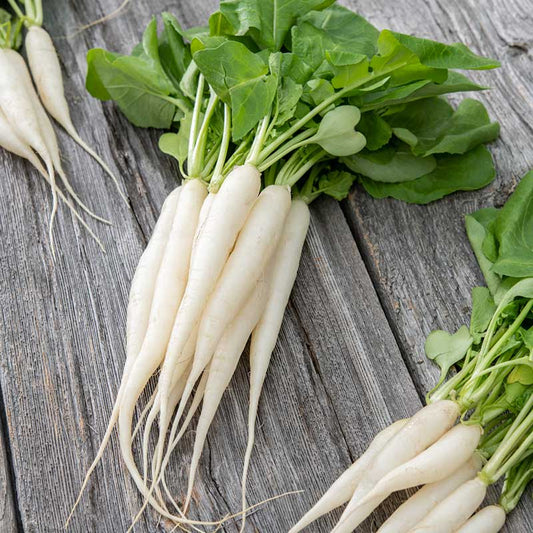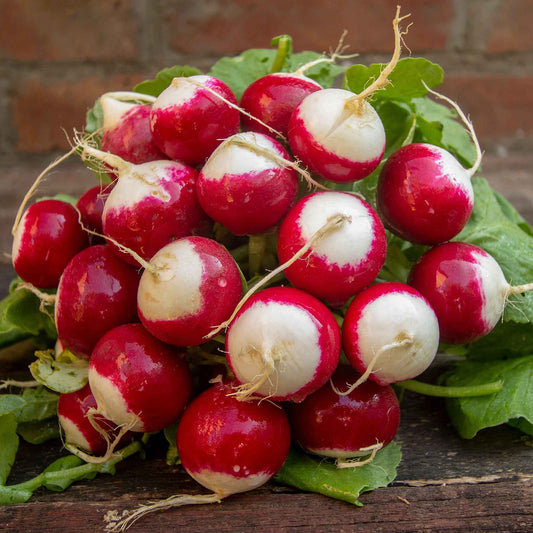-
main-collection-product-grid

Radish Seeds - Watermelon
Beautiful addition to salads and pickling jarsRadish Seeds - Watermelon
Beautiful addition to salads and pickling jarsRegular price As Low As $4.99Regular priceUnit price per -
main-collection-product-grid

Radish Seeds - Champion
Crisp with a mild white fleshRadish Seeds - Champion
Crisp with a mild white fleshRegular price As Low As $4.99Regular priceUnit price per -
main-collection-product-grid

Radish Seeds - French Breakfast
Mild tasting oblong red roots with white fleshRadish Seeds - French Breakfast
Mild tasting oblong red roots with white fleshRegular price As Low As $4.99Regular priceUnit price per -
main-collection-product-grid

Radish Seeds (Organic) - Cherry Belle
Mild kick makes it a favorite in salads and sandwichesSaleRadish Seeds (Organic) - Cherry Belle
Mild kick makes it a favorite in salads and sandwichesRegular price As Low As $6.99Regular priceUnit price per$21.99Sale price As Low As $6.99Sale -
main-collection-product-grid

Radish Seeds - Cherry Belle
Mildly peppery, crisp and crunchyRadish Seeds - Cherry Belle
Mildly peppery, crisp and crunchyRegular price As Low As $4.99Regular priceUnit price per -
main-collection-product-grid

Radish Seeds - Japanese Minowase Daikon
Great tasting fresh or pickled, can store for weeksRadish Seeds - Japanese Minowase Daikon
Great tasting fresh or pickled, can store for weeksRegular price As Low As $4.99Regular priceUnit price per -
main-collection-product-grid

Radish Seeds (Organic) - French Breakfast
Firm, crisp and elongated, perfect for dippingOut of StockRadish Seeds (Organic) - French Breakfast
Firm, crisp and elongated, perfect for dippingRegular price $6.99Regular priceUnit price per -
main-collection-product-grid

Microgreen Seeds - Microgreen Rainbow Blend
Small size packs a concentrated, nutritional punchMicrogreen Seeds - Microgreen Rainbow Blend
Small size packs a concentrated, nutritional punchRegular price As Low As $4.99Regular priceUnit price per -
main-collection-product-grid

Radish Seeds - Easter Egg
Peppery flesh in shades of pink and whiteRadish Seeds - Easter Egg
Peppery flesh in shades of pink and whiteRegular price As Low As $4.99Regular priceUnit price per -
main-collection-product-grid

Radish Seeds - Black Spanish Round
Heirloom from the 1500s, spicy flesh, stores well, stays crispRadish Seeds - Black Spanish Round
Heirloom from the 1500s, spicy flesh, stores well, stays crispRegular price As Low As $4.99Regular priceUnit price per -
main-collection-product-grid

Radish Seeds - Comet
Does well in warmer climates, ready to eat in 25 daysRadish Seeds - Comet
Does well in warmer climates, ready to eat in 25 daysRegular price As Low As $4.99Regular priceUnit price per -
main-collection-product-grid

Radish Seeds (Organic) - Japanese Minowase Daikon
Unusually shaped radish, mild taste, stores wellRadish Seeds (Organic) - Japanese Minowase Daikon
Unusually shaped radish, mild taste, stores wellRegular price $6.99Regular priceUnit price per -
main-collection-product-grid

Radish Seeds - German Giant
Maintains crisp texture through large sizeSaleRadish Seeds - German Giant
Maintains crisp texture through large sizeRegular price As Low As $4.99Regular priceUnit price per$58.99Sale price As Low As $4.99Sale -
main-collection-product-grid

Radish Seeds - Purple Plum
Excellent flavor wrapped in a fun colorSaleRadish Seeds - Purple Plum
Excellent flavor wrapped in a fun colorRegular price As Low As $4.99Regular priceUnit price per$26.99Sale price As Low As $4.99Sale -
main-collection-product-grid

Radish Seeds (Microgreen) - Sango
Easy, fast-to-grow, crunchy microgreen tastes just like radishesRadish Seeds (Microgreen) - Sango
Easy, fast-to-grow, crunchy microgreen tastes just like radishesRegular price As Low As $4.99Regular priceUnit price per -
main-collection-product-grid

Radish Seeds - Early Scarlet Globe
Crisp peppery white fleshRadish Seeds - Early Scarlet Globe
Crisp peppery white fleshRegular price As Low As $4.99Regular priceUnit price per -
main-collection-product-grid

Radish Seeds - White Icicle
Peppery kick in an elongated white rootRadish Seeds - White Icicle
Peppery kick in an elongated white rootRegular price As Low As $4.99Regular priceUnit price per -
main-collection-product-grid

Radish Seeds - Crimson Giant
Mild taste makes for the perfect snackRadish Seeds - Crimson Giant
Mild taste makes for the perfect snackRegular price As Low As $4.99Regular priceUnit price per -
main-collection-product-grid

Radish Seeds - Sparkler White Tip
Two toned radishes offer peppery flavorRadish Seeds - Sparkler White Tip
Two toned radishes offer peppery flavorRegular price As Low As $4.99Regular priceUnit price per -
main-collection-product-grid

Radish Seeds (Sprouting) - Red Arrow
Harvest nutritious red sprouts in just seven daysRadish Seeds (Sprouting) - Red Arrow
Harvest nutritious red sprouts in just seven daysRegular price As Low As $4.99Regular priceUnit price per
All about growing radish seeds
- 20 radish varieties
- Top performers in AAS trials
- Fast and easy to grow, great for children's gardens!
- Adds a colorful and peppery crunch to salads
the many benefits of growing radishes
Radishes get their scientific name, Raphanus sativus, from the Greek word (raphanus) meaning “quickly appearing.” This is no exaggeration as certain varieties go from seed to munchable in as little as 25 days! Originally cultivated in Southeastern Asia, radishes date back to 2700 B.C. Ancient Egyptians were even fond of radishes, using their seeds as a source of oil before olive trees were introduced. Radish seeds made their way to Europe in the 1500s and to the US by the 1600s. Radish Greens are also edible although they tend to become spiny as they age and are less popular than the root. Radish roots make crisp peppery additions to salads and veggie trays. Radish seeds also make an excellent quick crop of microgreens.
How to sow radish seeds for the best results
Radishes are a close cousin of kale, broccoli, and cauliflower, all found Brassicaceae family. Annual in zones 3 to 10, radish seeds can be sown directly in the garden in the spring or the fall. They prefer cold temperatures and may bolt/go to seed when weather becomes too hot. Seeds typically only take between three to five days to germinate. Keep soil moist after seeding to ensure even germination. Consider succession planting quickly-maturing varieties, seeding every 15 to 20 days for a continuous crop. Take note that some varieties, including Black Spanish Radish Seeds and Watermelon Radish Seeds, need to be planted after the summer solstice in northern regions because they are sensitive to day length and require shorter days to “bulb up” and mature.
Soil and light conditions for your radish crop
Radishes prefer full sun to partial shade for optimal growth and welcome increased shade during warmer months to keep them cool. They do best in rich soils, although nutrient needs are minimal because of how quickly they mature. Amend soil with a mild fertilizer or compost prior to and between plantings. Radishes can be grown in containers and are great for planting on a sunny balcony or patio. Optimal spacing is two to three inches, depending on the variety. Make sure to thin crops that are too thick before roots begin to form, about 10 days after planting.
Radishes are sometimes susceptible to wire worms and root maggots and do best in spaces where soil has already been worked. Adding a floating row cover can prevent these pests from laying their eggs and reaching your radishes. It can also extend your growing season by two to three weeks in both spring (earlier planting) and late fall (later planting).
For more information about planting, growing, and caring for radish seeds, see the Radish Seeds Planting Guide.



















